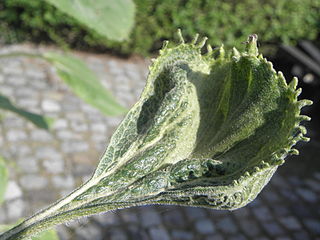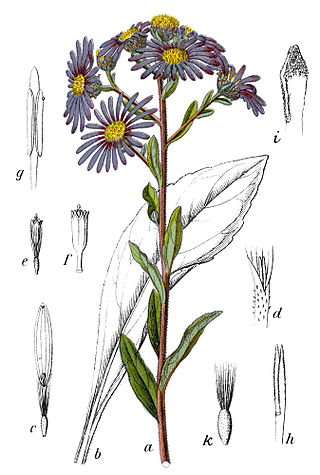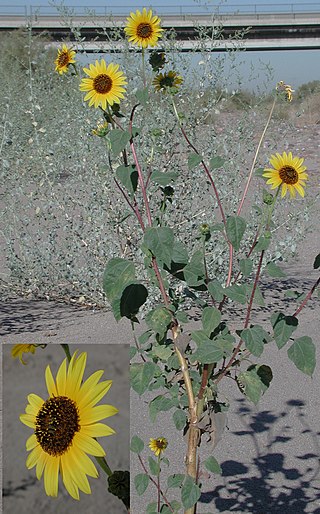
The common sunflower is a species of large annual forb of the genus Helianthus. It is commonly grown as a crop for its edible oily seeds. Apart from cooking oil production, it is also used as livestock forage, as bird food, in some industrial applications, and as an ornamental in domestic gardens. Wild H. annuus is a widely branched annual plant with many flower heads. The domestic sunflower, however, often possesses only a single large inflorescence atop an unbranched stem.

Sunflower seed are the seeds of the sunflower. There are three types of commonly used sunflower seeds: linoleic, high oleic, and sunflower oil seeds. Each variety has its own unique levels of monounsaturated, saturated, and polyunsaturated fats. The information in this article refers mainly to the linoleic variety.

Helianthus is a genus comprising about 70 species of annual and perennial flowering plants in the daisy family Asteraceae commonly known as sunflowers. Except for three South American species, the species of Helianthus are native to North America and Central America. The best-known species is the common sunflower. This and other species, notably Jerusalem artichoke, are cultivated in temperate regions and some tropical regions, as food crops for humans, cattle, and poultry, and as ornamental plants. The species H. annuus typically grows during the summer and into early fall, with the peak growth season being mid-summer.

Sorghum × drummondii, is a hybrid-derived species of grass raised for forage and grain, native to tropical and subtropical regions of Eastern Africa. It may also be known as Sorghum bicolor × Sorghum arundinaceum after its parents. Some authorities consider all three species to be subspecies under S. bicolor.
Sunflower is the common sunflower, a species of annual flowering plant first domesticated in the Americas.

The Eastern Agricultural Complex in the woodlands of eastern North America was one of about 10 independent centers of plant domestication in the pre-historic world. Incipient agriculture dates back to about 5300 BCE. By about 1800 BCE the Native Americans of the woodlands were cultivating several species of food plants, thus beginning a transition from a hunter-gatherer economy to agriculture. After 200 BCE when maize from Mexico was introduced to the Eastern Woodlands, the Native Americans of the eastern United States and adjacent Canada slowly changed from growing local indigenous plants to a maize-based agricultural economy. The cultivation of local indigenous plants other than squash and sunflower declined and was eventually abandoned. The formerly domesticated plants returned to their wild forms.

The Lygaeidae are a family in the Hemiptera, with more than 110 genera in four subfamilies. The family is commonly referred to as seed bugs, and less commonly, milkweed bugs, or ground bugs. However, while many of the species feed on seeds, some feed on sap (mucivory) or seed pods, others are omnivores and a few, such as the wekiu bug, are carnivores that feed exclusively on insects. Insects in this family are distributed across the world. The family was vastly larger, but numerous former subfamilies have been removed and given independent family status, including the Artheneidae, Blissidae, Cryptorhamphidae, Cymidae, Geocoridae, Heterogastridae, Ninidae, Oxycarenidae and Rhyparochromidae, which together constituted well over half of the former family.

Perennial sunflower is a crop of sunflowers that are developed by crossing wild perennial and domestic annual sunflower species.

Plasmopara halstedii is a plant pathogen infecting sunflowers. The species is one of many pathogens commonly referred to as downy mildew. P. halstedii originated in North America.

Asteroideae is a subfamily of the plant family Asteraceae. It contains about 70% of the species of the family. It consists of several tribes, including Astereae, Calenduleae, Eupatorieae, Gnaphalieae, Heliantheae, Senecioneae and Tageteae. Asteroideae contains plants found all over the world, many of which are shrubby. There are about 1,135 genera and 17,200 species within this subfamily; the largest genera by number of species are Helichrysum (500–600) and Artemisia (550).

Chlosyne lacinia, the bordered patch or sunflower patch, is a North and South American butterfly in the family Nymphalidae.

Cremastobombycia ignota is a moth of the family Gracillariidae. It is known from Illinois, Texas, Kentucky, Maine, New York, Massachusetts, Washington and Ohio in the United States.

Helianthus petiolaris is a North American plant species in the family Asteraceae, commonly known as the prairie sunflower or lesser sunflower. Naturalist and botanist Thomas Nuttall was the first to describe the prairie sunflower in 1821. The word petiolaris in Latin means, “having a petiole”. The species originated in Western United States, but has since expanded east. The prairie sunflower is sometimes considered a weed.
Cochylichroa arthuri, Arthur’s sunflower moth, is a species of moth of the family Tortricidae. It is found in North America, where it has been recorded from Saskatchewan, Manitoba, North Dakota, Indiana, Minnesota, Montana and Ohio.
Helianthus deserticola, the desert sunflower, is a plant species native to Arizona, Nevada and Utah. It grows in dry, sun-lit locations at elevations of 400–1,500 m (1,300–4,900 ft).

Helianthus anomalus, the western sunflower, is a species of plants in the family Asteraceae, found in the southwestern United States.
Dyella thiooxydans is a Gram-negative, aerobic, rod-shaped, thiosulfate-oxidizing, facultatively chemolithotrophic and motile bacterium from the genus of Dyella which has been isolated from rhizospheric soil of field with sunflowers from Junghwa-dong in Korea.

Charles Bixler Heiser Jr. (1920–2010) was a professor of botany, known as a leading expert on the sunflower genus Helianthus. He is also noteworthy as the author of a "series of popular books that did much to promote botany to the general public."
The agricultural weed syndrome is the set of common traits which make a plant a successful agricultural weed. Most of these traits are not, themselves, phenotypes but are instead methods of rapid adaptation. So equipped, plants of various origins - invasives, natives, mildly successful marginal weeds of agriculture, weeds of other settings - accumulate other characteristics which allow them to compete in an environment with a high degree of human management.
Helianthus annuus 'Russian Giant' is a cultivar of sunflower in the family Asteraceae. It is an annual.












